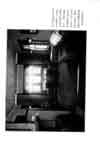TitleChapter II, "Everyman's House" book, by Caroline Bartlett Crane
CreatorCrane, Caroline Bartlett, 1858-1935, author
InstitutionWestern Michigan University
SubjectArchitecture, Domestic
SubjectDwellings
SubjectBetter Homes in America
Item NumberLA03a033
RelationPart of Caroline Bartlett Crane "Everyman's House" Collection
Type
collection, text
Formatjpeg
Description17
CHAPTER II
'SO BIG' A LITTLE HOUSE!
A DAY or so before our housewarming, chronicled in the preceding chapter, was due to take place, I was speeding up beautiful Westnedge Avenue in a trolley car, my mind filled with anxious premonition of finding four bodies--carpenters, finishers, decorators, furnishers--still occupying the same space at the same time, and gloomily convinced that our May Twelfth house would be ready sometime in June. It must have been this sad preoccupation which caused me to succumb to the name with which the general public had promptly christened our Demonstration House; for I said, 'Please let me off at the Model Home.' As he slowed down his car, the conductor looked at me quizzically. ' ?Model Home',' he repeated with relish. 'You know, I think that would make a fine model home for--a bachelor!'
18
EVERYMAN'S HOUSE
I turned upon him as a mother might whose precious baby had been called a brat. 'Why, the very idea!' I exclaimed. 'I'd have you know, sir, that this is a home for a father and mother, and six children.' (I admit I extemporaneously tucked another bed into the chamber being furnished for only two boys, but--who wouldn't?)
The embarrassed conductor, perhaps scenting something personal in the warmth of my defence[sic], began to apologize. The best I could do was to say I'd forgive him, if he'd promise to come during Demonstration Week and see for himself.
It does look small--our little Colonial cottage in its formal planting--a prim little tailor-made affair; deep cream clapboarded walls with moss-green roof, and blinds whose openings repeat the pattern of the dwarf arbor-vitae either side of the brick-paved stoop. A neighbouring garden club planted them there, whose guerdon is to be the lighting of these baby trees each Christmas Eve. It certainly does look small.
Of course, our house is small, for that matter, only 22' x 29' on the foundation, and a
[Page NA]
Living-room window-seat, with leaf-table for dining. Folded partition-screen between fireplace and door to kitchen. [photograph: LA03a005]
[Page NA: BLANK]
19
'SO BIG' A LITTLE HOUSE!
story-and-a-half. But this may be truthfully said--and one real-estate man said it for us, with an air of discovery and conviction: 'It's the biggest little house I ever saw!' That seems to be the impression gained by all who visit it.
This is doubtless because, first, the house is compact to the last degree. The plan eliminates halls, either for communication between rooms, or to reach the stairs. A second important element of 'bigness' consists in there not being an inch of waste space anywhere. All the room under the attic eaves, for example, is utilized by four closets, and two storerooms each 3'6 x 12'.
Again, the bathroom, so much admired that we feared having it carried off, is only 5' x 6'. And the kitchen is 10' x 9'6, and could well be no more than half that size, if it were not for considerations of air space in a room where a woman spends much of her day. All actual work, as will be seen in a later chapter, is done in a space of 5' x 8'.
A strictly logical order of chaptering this book would perhaps demand that I proceed at once to verify the introductory statement
20
EVERYMAN'S HOUSE
that this is a house built around a mother and her baby. However, it is very far from demanding a mother and a baby in order to function normally. To make this perfectly clear, I shall first describe the general features of the house on their merits in relation to any imaginable family combination--yes, even as a 'model home for a bachelor.'
Here, then, is the first-floor plan of Everyman's House. Please enter the front door with me. You will find yourself in a small vestibule whose only blank wall space is on either side of the front door. Room for the electric switches on one side; for a mirror with two or three hooks below on the other. Directly before you, comfortable stairs ascend under a graceful arch to the second floor. At the left side of the stairs is a roomy coat closet.
On the right, a door from the vestibule leads into the living-dining room; on the left is a door into the Mother's Room--if there is a mother with a baby; otherwise, into the dining room or library or den, or whatever you choose to make of this room. Thus, communication with the street, the second story, the living-dining room, the Mother's Room and the
21
'SO BIG' A LITTLE HOUSE!
closet for outdoor wraps is accomplished by a vestibule 6' x 3'6'. The vestibule has several other functions, to be spoken of later. This first trip over the house is to present the general plan, without a great deal in the way of detail.
Entering now the living-dining room at the right one may see at a glance that it is so planned as naturally to distribute the family and thus make it in effect a larger room than its actual dimensions. There are windows on three sides of this room, and a really superb view from every one of them. Everyman's House, we may state incidentally, faces the loveliest of our city parks. The two windows on the long side of the room look down the beautiful Kalamazoo valley. From the window seat at the far end (also from the kitchen window) one looks out over miles upon miles of wooded hills and slopes thick-dotted with town and suburban homes. This window seat is seven feet long. The lid is divided so that the halves may be opened separately. There's much more of significance in and around that window seat than can be elucidated just now.
22
EVERYMAN'S HOUSE
The fireplace is in the middle of the one unwindowed wall. The photographs show a davenport facing it from between the windows of the opposite wall. A large family can sit around the fireplace without crowding or moving cumbrous furniture. The easy chairs are naturally disposed to face that way. The fire can be enjoyed from the window seat at right angles to it. The bookcase is set between the fire and the reading lamp. A good-sized family can be happy and comfortable together in this big little room, 11' X 21'.
It appears, does it not? that we all prefer little rooms for our own personal use. Even in the 'grand houses,' aren't the big rooms really for entertaining? You will find the family and the family intimates drifting into the little room, or into the cozy alcove off the library, or--into Father's den! If Father is at all weak-kneed about it--if he relaxes discipline by ever so little--he will presently find his claim jumped on one pretext or another, the real, though unconscious, reason being that it's the smallest room in the house.
Since the kitchen is to have three chapters
23
'SO BIG' A LITTLE HOUSE!
to itself, we will pause here only to notice the roomy kitchen entry, which accommodates the refrigerator and several other adjuncts of kitchen service, and also serves as a vestibule for the children and a lodging place for their overshoes and everyday wraps. We will now pass to the basement stairs through a door on the east wall of the kitchen. The utter convenience of this basement adds much of bigness to our little house. You will note the thoroughly equipped laundry, with its set tubs, automatic water-heater and water-softener, the shower bath in one corner, and the clothes chute with the ventilated receiver beneath it; the furnace room with its grade entrance; the fuel room with the metal coal chute; the ventilated cold room with the large storage alcove beside it; and the open storage space under the stairs. The high ceiling and the cement partition walls are most unusual features in the cellar of so small a house.
Returning to the vestibule, we enter, through the door opposite the living room, the Mother's Room, which is the key room of the house. For the present we will notice only the windows to the east and south, the large clothes
24
EVERYMAN'S HOUSE
closet, the wall plug for a light above the bed, and the two doors, one opening directly into the bathroom, and the other into the kitchen. The Mother's Room, the kitchen, and the bathroom constitute together what we have called the Mother's Suite, to be described in a subsequent chapter. Please observe, also, that the first floor constitutes a complete flat for housekeeping.
Returning to the vestibule, we visit the second floor. At the head of the stairs is a passage the width of the stairs and just deep enough to afford space for the doors, on either side, opening into the bedchambers. The door in front of you opens into the lavatory-toilet of the future. The plumbing fixtures have only to be connected to the pipes already there. A metal clothes chute descends from this room to the kitchen and basement.
Now, as you open the door leading into either of the chambers, be prepared to exclaim, as they all do, 'Why, I had no idea these rooms could be so big and beautiful!' (Doubtless that is how our street-car conductor was so sadly misled.) The height of these chambers is 8'2'. One room is 13' wide; the other
25
'SO BIG' A LITTLE HOUSE!
11'. The length of each room is 14', besides a dormered alcove 5' x 3'6', which makes each room 17'6' long in the centre. Each room has two good closets, one of them fitted with drawers and shelves; also a storeroom, 3'6' wide, running across the width of the room. In our 'Better Homes' Demonstration we fitted up the larger chamber for two boys, and the hostess was instructed to show where a bed could be placed for a third boy. The other chamber was furnished for two girls.
'How big is my little house?' its fond mother asks, senselessly, if you like. And the little house smiles and twinkles and stretches out its arms--'S-o-o-o big!'--Big enough for Father and Mother and six children!
There! didn't I tell you?





















